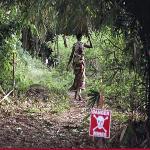The latest report on landmines has both good and bad news. It says governments have provided a record level of funding to remove the weapons. But at the same time the use of antipersonnel mines has increased.
Landmine Monitor 2011 shows funding for mine clearance reached an all-time high last year.
"It's very good news, particularly with the state of the global economy. We were quite surprised and pleased to record in 2010 the highest level of funding for mine action. And that total is $637 million. So it's a slight increase from last year, but given the state of the economy it feels just amazing and really shows governments' commitment to this issue," said Jacqueline Hansen, the Monitor's program manager.
More than 30 donors supported landmine clearing operations.
"The top five donors are the United States, the European Commission, Japan, Norway and Canada. And they collectively provide over half of all funding," she said.
Centimeter by centimeter
About 200 square kilometers of land were cleared of landmines in 2010. That's the most ever for a single year.
Hansen said, "Two hundred square kilometers, it's about five times the size of Paris. It may not sound like a lot for a global total, but when you're imagining people lying on their bellies on the ground prodding every centimeter looking for mines, suddenly 200 square kilometers sounds awfully big."
Nearly 390,000 antipersonnel mines and 27,000 anti-vehicle mines were destroyed in 2010.
Mine clearance is taking place in about 45 countries. The biggest operations are in Afghanistan and Cambodia. But while landmines are being removed, Hansen said more are being buried.
"This year we've seen an increase in government use of antipersonnel mines. We've seen new use in Libya. New use in the past couple months in Israel. Ongoing use in Myanmar. And we have very serious allegations since our report went to print of use in Syria," she said.
Losing legs, arms, lives
The landmine report, released in Bangkok, Thailand, said thousands were killed or injured in 2010.
"We've recorded 4,191new casualties in 2010. But we know that number's not correct because there's underreporting in a lot of different countries. Especially in the middle of conflict zones, it's just difficult to get accurate data. So probably the real number is probably upwards of 6,000. But when we look at what that means in the big picture, it means we have hundreds of thousands of survivors. And that total keeps growing year after year and these people need assistance for the rest of their lives," Hansen said.
The Landmine Monitor keeps track of who's producing the weapons.
"There are 12 countries that we list as producers of antipersonnel mines, largely because they reserve the right to produce mines. But in terms of mines actually coming off the production lines right now, we believe that there [are] only three countries actively producing – Myanmar/Burma, India and Pakistan," she said.
Since the international landmine treaty was signed in 1997, 158 countries have become parties to it. The Obama administration, like previous U.S. administrations, has not signed. Despite that, the U.S. does comply with many of its provisions. The International Campaign to Ban Landmines says the United States has not used antipersonnel mines since 1991 and has not exported them since 1992.
